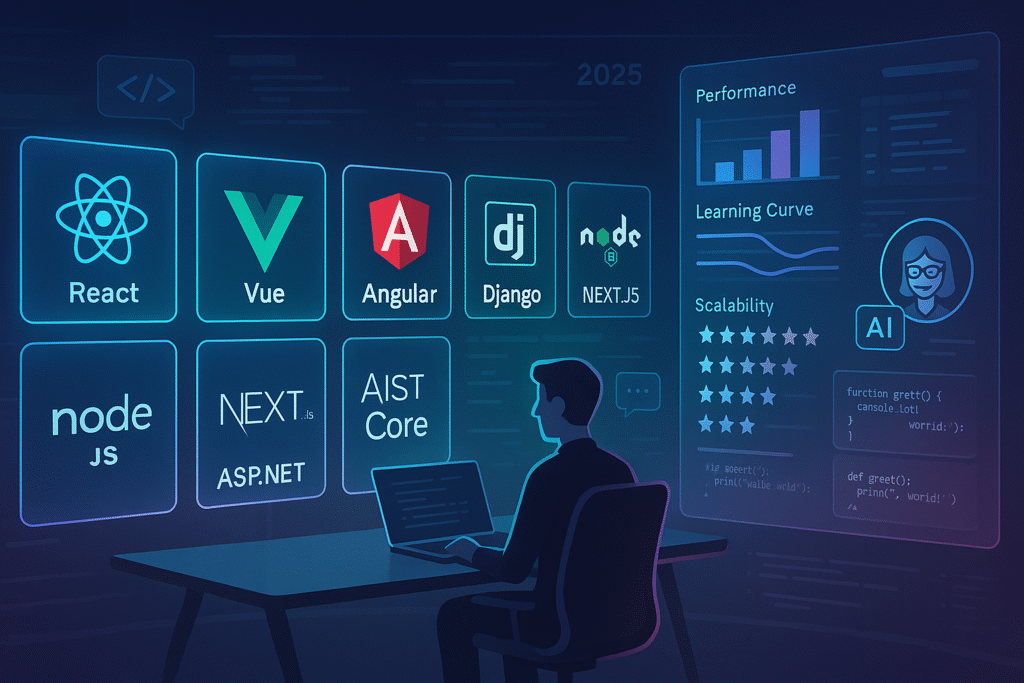Introduction
Web development changes fast. As a result, picking the right framework matters a lot. A good choice speeds up your work, while also boosting performance and making upkeep simple. However, with so many options out there, making a choice can be hard. Therefore, this guide will help you pick the best framework for your project.

Understanding Frameworks in Modern Web Development
Frameworks give you a clear path to build apps.
Generally, they come with ready-made tools, workflows, and safety features. This makes your work faster and more efficient. Unlike single tools, frameworks keep everything neat and easy to maintain.
In addition, web frameworks come in different types. Front-end ones like React, Vue, and Angular build what users see. Meanwhile, back-end frameworks like Django, Express, and ASP.NET Core handle server work. Moreover, some, like Next.js and Nuxt.js, do both. Each has its own strengths. Consequently, your project needs should guide your choice.
Benefits of Choosing the Right Web Development Framework
A good framework helps in many ways.
- First, it speeds up work by handling routine tasks.
- Second, it keeps your app safe from threats.
- Furthermore, it makes code more uniform, so teams work better together.
- Eventually, it cuts down on upkeep costs.
Strong community support is another plus. In particular, popular frameworks offer guides, docs, and extra tools. As a result, fixing problems becomes easier. Additionally, an active community also means regular updates and security fixes.
Key Factors to Consider When Choosing a Web Development Framework:
Think about your project needs first
Obviously, the size and type of your app will show if you need a simple or feature-rich framework. Besides that, think about growth too. Some frameworks handle large apps better. If you’re short on time, nevertheless, pick one that helps you build quickly.
Tech factors matter as well. For instance, some frameworks are easy to learn. Others need more skill. Therefore, check how steep the learning curve is, how good the docs are, and if testing is simple. In the end, a framework that fits your skills saves time.
Business factors count too. For example, if your team knows a framework well, work will go faster. Also, think about long-term support and costs. Although some frameworks need license fees, many are free. Subsequently, check if they fit your budget.
Popular Front-End Frameworks in 2025:
React
React leads in front-end work. Indeed, its part-based setup and rich tools make it flexible and strong.
Angular
Angular works well for big projects. Specifically, it has built-in tools for routing, forms, and data. Yet it’s hard to learn, so your team might need training.
Vue.js
Vue.js is easier to learn than Angular. Notably, its Composition API helps organize code better. Thus, it’s good for folks moving from basic web design.
Svelte
Svelte turns code into smaller, faster apps during the build step. In addition, with SvelteKit, it’s now even more useful.
Modern Back-End Frameworks for Web Development:
Node.js
Node.js is common for back-end work. Particularly, Express, Fastify, and NestJS are top picks.
- Express is light and flexible.
- Fastify aims for speed.
- On the other hand, NestJS offers structure, which helps with large projects.
Django & FastAPI
Django includes safety, login, and database tools. In contrast, FastAPI makes high-speed APIs, perfect for modern apps.
ASP.NET Core
ASP.NET Core is very secure and works well with Microsoft tools. Hence, it’s ideal for business apps.
Full-Stack Solutions for Web Development:
Next.js
Next.js is the best full-stack choice for React users. Above all, it can render pages on the server, make static sites, and stream content. This helps with speed and search rankings. Similarly, it also makes building big apps easier.
Remix
Remix puts the server first. Consequently, this makes data loading and page routing better. Furthermore, apps run faster, even on slow networks.
Nuxt.js
Nuxt.js gives Vue users a clear structure. Just like Next.js, it supports server rendering and static sites. As a result, this makes building apps simpler.
How to Select the Best Web Development Framework:
Use a clear process to choose
Initially, list what your project needs. Then compare frameworks on growth potential, ease of use, and learning curve. After that, since real-world speed matters, try a small test project first.
After picking a framework, plan how to use it. First of all, create a timeline. Next, set coding rules. Finally, train your team if needed. Overall, good planning leads to smooth work.
Common Mistakes When Choosing a Web Development Framework:
Popularity vs. Suitability
Many pick frameworks just because they’re popular. While this matters, it’s not the only thing to check. Instead, focus on how well it meets your needs.
Ignoring Long-Term Maintenance
Some frameworks need frequent updates or have small support groups. Unfortunately, this makes upkeep hard. Therefore, pick one with good support to avoid future problems.
Overlooking Team Expertise
If you ignore what your team knows, work slows down. Even a great framework fails if your team can’t use it well. To clarify, balance new tech with what’s practical.
Future Trends in Web Development Frameworks:
Web dev keeps changing. Currently, AI now helps with coding and fixing bugs. At the same time, WebAssembly lets you build fast apps in many coding languages.
Edge computing makes apps faster by cutting server load and delays. In the meantime, micro-frontends and mix-and-match parts are changing how we build large apps.
Conclusion
Picking the right web framework means balancing tech, business, and team needs. Of course, no single option works for every project. Take time to evaluate carefully. By using a clear process and staying current, you can build strong, lasting apps. Ultimately, as tech changes, review your choices often to stay ahead in web dev.
Ready to build your next project with the right framework? Contact us today to get started!



